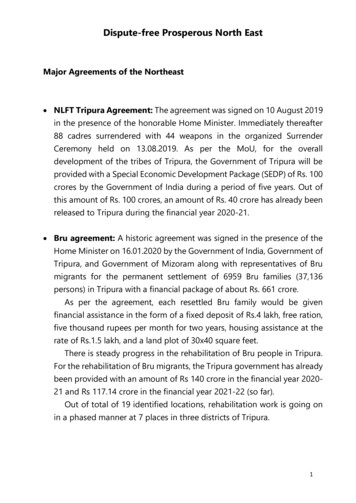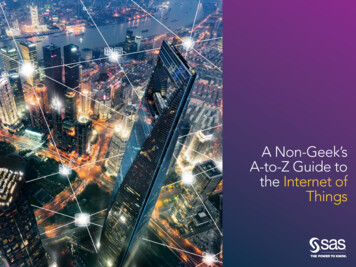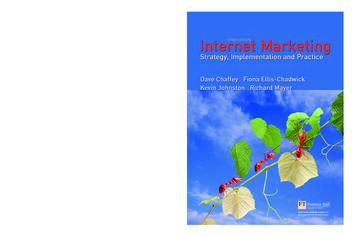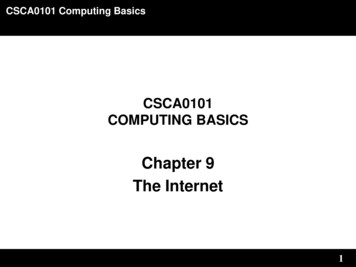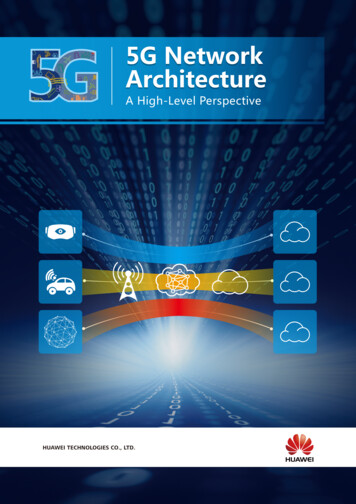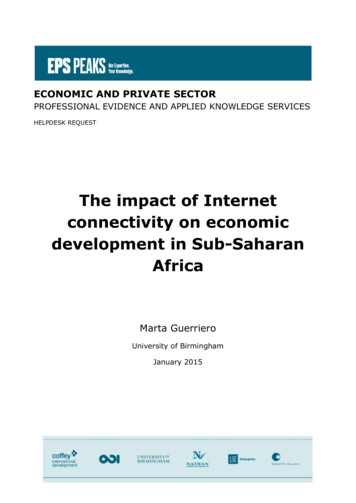
Transcription
ECONOMIC AND PRIVATE SECTORPROFESSIONAL EVIDENCE AND APPLIED KNOWLEDGE SERVICESHELPDESK REQUESTThe impact of Internetconnectivity on economicdevelopment in Sub-SaharanAfricaMarta GuerrieroUniversity of BirminghamJanuary 2015
The impact of Internet connectivity on economic development in Sub-Saharan AfricaEPS-PEAKS is a consortium of organisations that provides Economics and Private SectorProfessional Evidence and Applied Knowledge Services to the DfID. The core services include:1) Helpdesk2) Document library3) Information on training and e-learning opportunities4) Topic guides5) Structured professional development sessions6) E-BulletinTo find out more or access EPS-PEAKS services or feedback on this or other output, visit theEPS-PEAKS community on http://partnerplatform.org/eps-peaks or contact Alberto Lemma,Knowledge Manager, EPS-PEAKS core services at a.lemma@odi.org.uk.Disclaimer Statement:The views presented in this paper are those of the authors and do not necessarily representthe views of Consortium partner organisations, DFID or the UK Government. The authors takefull responsibility for any errors or omissions contained in this report.i
The impact of Internet connectivity on economic development in Sub-Saharan 34.44.55List of figuresAbbreviationsIntroductionOverviewAim of the reportMethodologyStructure of the reportInternet connectivity in Sub-Saharan AfricaInternet penetration and accessibilityBarriers to the expansion of the Internet: price and speedImpact on SMEs growthFirm profitabilityFirm efficiencyImpact on economic development and the poorFinancial inclusionSocial inclusionHealthEducationAgricultureConclusions and policy 1617181921ii
The impact of Internet connectivity on economic development in Sub-Saharan AfricaList of igureFigure1:2:3:4:5:6:7:8:9:Percentage of Internet users and PPP GDP per capita, current international (2013).1Percentage of Internet users and poverty headcount ratio, 2/day (2011-2013).2Individuals using the Internet in Africa, in millions (2005-2014).4Individuals using the Internet by region, annual growth rates (2007-2014).4Active mobile-broadband subscriptions by region, annual growth rates (2010-2014). 5Percentage of individuals using the Internet and accessing it at home, SSA.6Fixed-broadband prices and PPP GDP per capita, current international (2013).7Fixed-broadband prices, as a percentage of GNI per capita, SSA, 2013.8Use of emails and websites (as a percentage), SMEs, SSA, various years (20062013).10Figure 10: Platform comparison, Africa, October 2009-October 2014.19iii
The impact of Internet connectivity on economic development in Sub-Saharan bpsMDGPOSPPPSMESSAUNPACSUSDWHOAfrican Medical Research and Education FoundationBrazil, India, ChinaCommonwealth of Independent StatesGross Domestic ProductGross National IncomeDeutsche Gesellschaft für Technische Zusammenarbeit(German Federal Enterprise for Technical Cooperation)Information and Communication TechnologyInternational Fund for Agricultural DevelopmentInternational Telecommunication UnionMegabit per secondMillennium Development GoalPoint of SalePurchasing Power ParitySmall- and Medium-sized EnterpriseSub-Saharan AfricaUnited Nations Public Administration Country StudiesUnited States DollarWorld Health Organizationiv
The impact of Internet connectivity on economic development in Sub-Saharan Africa1Introduction1.1OverviewRecent international development literature perceives the Internet as a vast potential forinclusive growth and socio-economic development (Dalberg, 2013). Not only could it increaseproductivity and contribute to the overall GDP of an economy, but it could also help connectremote populations to markets, promote citizens’ access to social services, expand educationalopportunities, create platforms for innovation and increase people’s freedoms and access togovernment services (Madon, 2000).When looking at cross-country data on Internet penetration and economic development (WorldBank, 2014b), we can observe a strong positive correlation between percentage of Internetusers and PPP GDP per capita (see Figure 1 below).Figure 1: Percentage of Internet users and PPP GDP per capita, current international (2013).Source: Adapted from ITU and World Bank data.A similar exercise can be done by analysing poverty data. In particular, we can use the povertyheadcount ratio at 2 a day, in PPP, as a percentage of the total population (World Bank,2014b). The two variables (see Figure 2 below) are quite clearly negatively associated:countries with high Internet penetration exhibit low poverty rates and countries with lowInternet penetration are generally poorer. However, the simple presence of a strongcorrelation does not necessarily imply causation. While on the one hand it is possible to thinkthat the Internet may contribute to promoting economic growth and reducing poverty, on theother hand a very plausible explanation is that the wealthier a country is, the better theinfrastructures which allow access to and penetration of the Internet among the population willbe, since the demand for Internet services rises with wealth. As a consequence, there is aclear need for further investigation.Many studies have sought to identify and understand the economic benefits of the Internet.However, the majority of these focus primarily on developed countries (McKinsey GlobalInstitute, 2011) and are mainly restricted to case studies and qualitative arguments (WorldBank, 2009). Recent cross-country empirical literature has attempted to quantify, usingmacro-level data, the contribution of Internet connectivity at all levels of economic1
The impact of Internet connectivity on economic development in Sub-Saharan Africadevelopment and established that the Internet is a dynamic tool for stimulating growth. Inparticular, with specific reference to developing countries, a macro-level econometric analysisperformed by the World Bank (2009) reports that a 10% increase in broadband and a 10%increase in wire line Internet penetration are associated to a 1.38% and a 1.12% increase inGDP growth, respectively1. Despite the attempt to provide robust estimates, the study doesnot explicitly deal with the endogeneity issue originated from the potential reverse causalitybetween Internet penetration and economic growth. This could have biased the results, whichneed to be carefully looked at.Figure 2: Percentage of Internet users and poverty headcount ratio, 2/day (20112013).Source: Adapted from ITU and World Bank data.Empirical literature has also studied the impact of broadband accessibility and speed ondevelopment. A microeconomic study (Ericsson, 2013) using survey data of both developingand developed countries established that doubling broadband speed can increase GDP growthof an economy by 0.3%. Specifically in BIC countries, introducing a 0.5 Mbps broadbandconnection increases household income by USD 800 per year, and upgrading the broadbandconnection from 0.5 to 4 Mbps raises household income by USD 46 per month. However, asalso mentioned in the report, the sample size for BIC countries (just above 3,000 respondentsaged 15-69) is relatively small, and consequently the results should be interpreted with care.As a consequence, existing cross-country differences in Internet penetration and access maycreate significant long-run growth benefits for the most connected countries.1.2Aim of the reportThe purpose of this report is to identify and analyse existing evidence on the impact ofincreased Internet connectivity on economic development in Sub-Saharan Africa (SSA). Inparticular, the study attempts to summarise key findings from the literature on the benefitsand opportunities for business development (including SMEs) and poverty reduction (focusingon the impact on lower income Internet users) in the developing world.1The same study also concludes that the Internet has a higher growth impact relative to other Information andCommunication Technologies (ICTs), such as for example fixed and mobile telephony (0.73% and 0.81% increase inGDP growth, respectively).2
The impact of Internet connectivity on economic development in Sub-Saharan AfricaThe report intends to inform wider strategy for economic development in SSA through thepromotion of Internet connectivity and usage policies and programmes.1.3MethodologyThe analysis contained in this report has been conducted through desk research. The reportdescribes evidence available from a literature review on the impact of Internet usage oneconomic development – covering research papers, government, multilateral and independentreports, as well as discussion and working papers. In addition, the study also discusses dataand findings from various broad-based surveys of individuals and firms in SSA, as well as a fewsuccess stories of initiatives and programmes implemented in various Sub-Saharan Africancountries.The literature on the advantages and disadvantages of the diffusion and use of the Internet foreconomic development is growing quickly, although extremely recent. For the purpose of thisstudy, the discussion of case studies and impact estimates mainly focuses on Sub-SaharanAfrican countries. Contrary to many previous studies, which define ‘economic development’narrowly by concentrating mainly on GDP levels and growth, we expand our focus to manydifferent dimensions of socio-economic development, attempting to provide a detailed analysisof the value of the Internet.1.4Structure of the reportThe report proceeds as follows. Section 2 will provide a background on Internet connectivity inSSA, and analyse Internet use and penetration, as well as Internet access and some relevantissues related to it (such as, for example, Internet prices and speed). Section 3 will examine,with the use of data and findings from business surveys, the effect of Internet connectivity onSMEs development, growth and survival. Section 4 will discuss the impact of Internet on otherdimensions of socio-economic development, such as social and financial inclusion, health,education and agriculture, with a particular focus on the poor and also including a fewsuccessful Internet connectivity initiatives. Section 5 will summarise the main findings of thereport and suggest conditions and implications for policy implementation.3
The impact of Internet connectivity on economic development in Sub-Saharan Africa2Internet connectivity in Sub-Saharan Africa2.1Internet penetration and accessibilityThe ITU (2014c) estimates that by the end of 2014 there will be almost 3 billion Internet usersin the world. About two thirds of them will come from the developing world, where the numberof Internet users has been growing rapidly and is expected to double in only 5 years (from 974million in 2009 to 1.942 billion in 2014). In Africa, in particular, Internet penetration hasgrown more than tenfold, from 17 million Internet users in 2005 to an estimated 172 million in2014 (see the Figure below).Millions of usersFigure 3: Individuals using the Internet in Africa, in millions (2005-2014).20018016014012010080604020-YearSource: Adapted from ITU data.According to the ITU statistics (2014a), Africa is the fastest growing region in the world interms of Internet penetration, with a growth rate in Internet users (see Figure 4 below) of16.05% between 2013 and 2014 (more than twice as high as the global average growth of7.85%).Internet users (% growth)Figure 4: Individuals using the Internet by region, annual growth rates (2007-2014).6050403020102007/2008 2008/2009 2009/2010 2010/2011 2011/2012 2012/2013 2013/2014YearAfricaArab StatesAsia & PacificCISEuropeThe AmericasSource: Adapted from ITU data.This growth has been mainly driven by a vast expansion in mobile-broadband, a marketsegment growing very fast in the whole world. Mobile-broadband penetration in Africa is4
The impact of Internet connectivity on economic development in Sub-Saharan Africaestimated to reach 19.0% in 20142, up from only 1.8% in 2010. Moreover, despite aconsiderable slowdown in growth since 2010-2011, mobile-broadband subscriptions are stillrising at a rate of 46.73% today (as can be seen in the Figure below). A great number ofmobile Internet users are mobile-only, especially in developing countries3. In Africa, 38% ofonline page views are from mobile devices, and mobile continues to grow extremely quickly asa source of Internet traffic: mobile Internet usage (as a percentage of overall Internet use) inAfrica has increased by 18% in the last year, between May 2013 and May 2014 (Meeker,2014). Additionally, smartphone penetration is today 31% in Kenya, 29% in Nigeria and 47%in South Africa (On Device Research, 2014).Mobile-broadband subscrptions(% growth)Figure 5: Active mobile-broadband subscriptions by region, annual growth /20132013/2014YearAfricaArab StatesAsia & PacificCISEuropeThe AmericasSource: Adapted from ITU data.However, the potential of the Internet is still largely unexplored in Africa, and in particular inSSA, which is the main focus of this study. As a matter of fact, Internet penetration in thecontinent, despite rocketing in recent years, was just 2.4% in 2005, 9.8% in 2010 and willreach only 19.0% by the end of 2014. This is a much lower figure than anywhere else in theworld4. Moreover, only approximately 6% of the world’s Internet users live in Africa, despite itbeing home to more than 15% of the world’s total population (ITU, 2014a). Furthermore,Internet use in Africa is mainly an urban phenomenon: even in South Africa, only 24% ofInternet users are rural (Balancing Act, 2014).The diffusion of the Internet cannot be measured only in terms of the number of connectedindividuals, but also in terms of its accessibility. By the end of 2014, only around one out often households (11.1%) will have Internet access at home in Africa, contrary to an average of31.2% in all developing countries (ITU, 2014a). Nevertheless, these figures were considerablylower in 2009-2010 when Internet access in the home was around 6.5% (average for a sampleof Ghanaians, Kenyans, Tanzanians and Zambians) (Audience Scapes, 2010).2On the contrary, despite double-digit growth over the last four years, fixed-broadband penetration in Africa is verylow, at only 0.4% in 2014. This is to some extent due to low computer penetration (only 7.8% of households in Africahave a computer).3In Kenya, for example, mobile data/Internet subscriptions (13.26 million) account for 99.26% of total Internetsubscriptions (13.36 million) (Communication Authority of Kenya, 2014).4Internet user penetration has reached 40% globally and 32% in the developing world (ITU 2014).5
The impact of Internet connectivity on economic development in Sub-Saharan AfricaFigure 6: Percentage of individuals using the Internet and accessing it at home, SSA.Internet users (2013):0Access at home (various years, 2009-2012):2040SeychellesSouth AfricaKenyaMauritiusNigeriaCape VerdeSwazilandS. Tomé & PrincipeSudanSenegalAngolaZimbabweEquatorial ozambiqueLesothoBeninLiberiaTogoBurkina FasoTanzaniaCentral African Rep.Guinea-BissauCôte d'IvoireChadMaliCongo (Dem. Rep.)MadagascarEthiopiaNigerSierra LeoneGuineaSomaliaBurundiEritrea60Mauritius (2012)Seychelles (2011)South Africa (2012)Sudan (2012)Cape Verde (2012)Ghana (2012)Namibia (2011)Nigeria (2010)Gabon (2010)Angola (2010)Malawi (2012)Zimbabwe (2011)Senegal (2010)Kenya (2009)Comoros (2010)Mali (2011)Burkina Faso (2010)Cameroon (2010)Djibouti (2009)Benin (2011)Zambia (2010)Eritrea (2010)Côte d'Ivoire (2010)Togo (2010)Guinea (2010)Congo (2011)Congo Dem. Rep. (2010)Burundi 221.91.71.41.31.21.11110.60.101020Internet access at homeIndividuals using the InternetSource: Adapted from ITU data6304050
The impact of Internet connectivity on economic development in Sub-Saharan AfricaIn the same survey of more than 8,000 adults in four Sub-Saharan African countries (Ghana,Kenya, Tanzania and Zambia) carried out in 2009-2010 by Audience Scapes (2010), amongthe Internet users only 18.6% are found to access Internet most frequently at home, the otherrespondents are connected mainly at work (16.7%), in Internet cafes (31.7%) and via mobilephone or other devices (7.1%).Nonetheless, large variations exist across different countries. In particular, in SSA (see theFigure above), Seychelles and South Africa rank highest in Internet penetration (with 50.40%and 48.90% of Internet users, respectively); while the countries with the least Internetpenetration are Eritrea and Burundi (only 0.90% and 1.30%, respectively). Seychelles andSouth Africa are also among the top three countries in SSA in terms of Internet access athome (where 34.0% and 33.9% households have access to Internet, respectively), togetherwith Mauritius (39.2%); whereas Burundi appears again at the bottom of the ranking (withonly 0.1% of the households connected to the web) (ITU, 2014a).2.2Barriers to the expansion of the Internet: price and speedA variety of factors may impede the access and penetration of the Internet. Only 26.6% of theindividuals sampled in Ghana, Kenya, Tanzania and Zambia (Audience Scapes, 2010) thinkthat the Internet is easy to use, 40.7% of them believe that it is difficult to find places wherethey can access the Internet, and for 45.3% of the respondents Internet access is expensive.In particular, the price of the Internet is very critical for policies aimed at increasing Internetconnectivity in developing countries. Despite the fact that broadband is becoming moreaffordable in the world – over the past five years, fixed-broadband prices as a share of GNI percapita have dropped by 65% (Broadband Commission, 2014b) – the Internet is still too highlypriced in a variety of developing countries. Affordability relates to service pricing, as well asthe cost of smart-phones, tablets, laptop computers or other devices which permit Internetaccess.Figure 7: Fixed-broadband prices and PPP GDP per capita, current international (2013).Source: Adapted from ITU and World Bank data.If we assume that individuals can afford broadband only if it costs less than 5% of their annualincome, around 1.7 billion people around the world do not possess enough money to havefixed-broadband access and over 2.6 billion people cannot afford mobile-broadband7
The impact of Internet connectivity on economic development in Sub-Saharan Africa(Broadband Commission, 2014b). At the end of 2013, on average, the cost of an entry-levelfixed-broadband plan in the developing world was 25.8% of GNI per capita (ITU, 2014b)5.Fixed- broadband prices (relative to GDP per capita) seem to be negatively correlated to thelevel of economic development of the country. Figure 7 above plots cross-country data onfixed-broadband prices and GDP per capita. The diagram exhibits a strong negative correlationbetween the two variables.Africa is the region with the most expensive fixed-broadband prices, with an average price ofmore than 100% of GNI per capita, consistent with fixed-broadband penetration in the region.Figure 8 below shows how, in SSA, fixed-broadband prices are higher than 5% of GNI percapita in 30 out of 35 countries (ITU, 2014b). Moreover, in 13 countries in SSA the cost of theInternet is greater than 50% of GNI per capita. In particular, the figure is shockingly high forthe Central African Republic, where the price of fixed-broadband is 2193.65% of GNI percapita; in other 6 Sub-Saharan African countries (Togo, Madagascar, Nigeria, Burundi, Malawiand Rwanda) the cost of fixed-broadband is also more than 100% of GNI per capita (ITU,2014b).Figure 8: Fixed-broadband prices, as a percentage of GNI per capita, SSA, 2013.14121086420Source: Adapted from ITU data.Despite it being the conventional measure of broadband prices proposed by the ITU, it couldbe argued that expressing broadband prices as a percentage of GNI might reflect the level ofeconomic development of the country more than the cost of broadband. Consequently, wecollect data on monthly fixed-broadband prices (PPP USD) from the International BroadbandPricing Study (2014). When ranking the prices of the cheapest listed plan by country inDecember 2013, it is possible to notice that 8 out of the 10 most expensive countries are inSub-Saharan Africa (for example, the cheapest monthly fixed-broadband plan costs 237.5 inBurundi, 186 in Uganda and 106.82 in Madagascar).Despite mobile-broadband penetration in Africa being higher than fixed-broadband, a similarstory can be told in relation to its prices. The average prices for a computer-based mobilebroadband service with 1GB monthly data allowance and a handset-based plan with 500MBmonthly allowance are more than 22% and 15% of GNI per capita in Africa, respectively. Inthe rest of world, average prices for mobile-broadband are less than 10% of GNI per capita6(ITU, 2014b).Another important issue related to Internet connectivity in SSA is related to the reliability ofthe Internet connection: in the continent there are indeed vast cross-country and cross-citydifferences in broadband speed. The testing company Ookla provides monthly rankings ofglobal Internet speeds in the form of an Internet index, NetIndex (Ookla, 2014). Today56As opposed to less than 2% in the developed world.And again less than 2% in the developed world.8
The impact of Internet connectivity on economic development in Sub-Saharan Africa(November 2014), the countries with the slowest average broadband download speed in theworld are in SSA – Niger (0.60 Mbps), Burkina Faso (0.84 Mbps), Gambia (1.39 Mbps), Guinea(1.40 Mbps) and Benin (1.52 Mbps) –, with figures much below the global average downloadspeed (21.5 Mbps). Also, Sub-Saharan African countries retain the slowest average broadbandupload speeds – Niger (0.21 Mbps), Burkina Faso (0.29 Mbps) and Guinea (0.44 Mbps) –, asopposed to a global and a G8 average of 9.8 and 11.4 Mbps, respectively. In terms of mobiledata speed, Sudan is at the bottom of the rankings, with 1.85 Mbps download and 0.46 Mbpsupload speed7. Even the Sub-Saharan African countries with the fastest connectivity are veryfar from the world averages8 (Ookla, 2014).However, the speed of the Internet connection is accelerating fast in all Sub-Saharan Africancountries, and in particular in urban areas. This is evident by looking at data for the last 4years in some of the largest cities in the continent. The average broadband speed in Lagos,Nigeria, was 0.77 Mbps in November 2010 and 5.71 Mbps today; Johannesburg, South Africa,saw a doubling of average broadband speed, from 3.09 Mbps in November 2010 to 7.41 Mbpstoday; Dar Es Salaam, Tanzania, experienced an even greater acceleration, going from anaverage of 0.6 Mbps 4 years ago to 6.7 Mbps today (Ookla, 2014).In conclusion, Internet access and use is increasing, and it is expected to continue to do soover the next few years, in many Sub-Saharan African economies. According to a survey ofInternet users in Tanzania and Zambia (Audience Scapes, 2010), a sizeable 27.7% of theindividuals who access the Internet today started using it less than a year ago, nearly half(45.9%) of them between 1 and 5 years ago, while only 14.7% started using it more than 5years ago. Concerning mobile Internet in Kenya, Nigeria and South Africa (On DeviceResearch, 2014), the figures are similar, with nearly one third (29%) of the users comingonline for the first time on their phones in the last 12 months, 41% between 1 and 5 years agoand 30% of them going online over 5 years ago. Internet users in SSA are consequently youngand unexperienced. However, there is increasing awareness of the significance of the Internet:49% of the adults in Ghana, Kenya, Tanzania and Zambia (Audience Scapes, 2010) intend touse the Internet in the future.This point is fundamental when analysing the impact of Internet connectivity, expected toincrease significantly in the next few years. World Wide Worx (2012) suggested that “it is timeon the Internet, rather than numbers on the Internet” to determine its impact. As a matter offact, only individuals with some experience (around 5 years) on the Internet are ready toengage with the high-end services of the digital economy (such as, for example, Internetfinance and online shopping).A study by Balancing Act (2014), with consumer and business survey data from several SubSaharan African countries, predicts that Internet connection ownership will increase to 10-25%of the population over the next five years.78The world average download speed is 11Mbps and upload speed is 4.5Mbs.Mauritius (16.89Mbps) has the fastest broadband download speed, Madagascar has the fastest upload speed(10.16Mbps) and South Africa has the fastest mobile data download and upload speed (9.64Mbps and 3.40Mbps,respectively).9
The impact of Internet connectivity on economic development in Sub-Saharan Africa3Impact on SMEs growthSmall- and medium-sized enterprises (SMEs) are important drivers of economic developmentin SSA, where it is estimated that they account for about 90% of all businesses.Figure 9: Use of emails and websites (as a percentage), SMEs, SSA, various years(2006-2013).Medium-sized firms (20-99):AngolaBeninBotswanaBurkina FasoBurundiCabo VerdeCameroonCentral Afr. Rep.ChadCongo, Dem. Rep.Congo, Rep.Côte d'IvoireEritreaEthiopiaGabonGambia, iaNigerNigeriaRwandaSenegalSierra LeoneSouth ll-sized firms (5-19):AngolaBeninBotswanaBurkina FasoBurundiCabo VerdeCameroonCentral Afr. Rep.ChadCongo, Dem. Rep.Congo, Rep.Côte d'IvoireEritreaEthiopiaGabonGambia, iaNigerNigeriaRwandaSenegalSierra LeoneSouth AfricaSwazilandTanzaniaTogoUgandaZambiaZimbabwe0.0 20.0 40.0 60.0 80.0 100.0Use e-mail0.0Have a websiteUse e-mailSource: Adapted from World Bank data.1020.0 40.0 60.0 80.0Have a website
The impact of Internet connectivity on economic development in Sub-Saharan AfricaThey are, for example, 91% of formal businesses in South Africa, 92% in Ghana and 98% inMozambique (Abor & Quartey, 2010; Accenture, 2014).Recent studies (Madon, 2000) have found that Internet usage contributes to profitability,productivity, competitiveness and survival of SMEs. However, according to the World BankEnterprise Survey data (World Bank, 2014a), a large number of companies in SSA are notconnected to the web. For a majority of the countries, only 20% (or less) of small firms and45% (or less) of medium firms have their own website, and only 60% (or less) of small firmsand 80% (or less) of medium firms use emails to interact with clients and/or suppliers (seeFigure 9 above). As a result, this is an important yet vastly unexplored opportunity for sectorgrowth.In particular, the Internet has been found to produce both top-line growth and bottom-lineimprovements for SMEs (Dalberg, 2013).3.1Firm profitabilityOn the one hand, SMEs are able to derive profits from the Internet as it enables companies tocut costs and increase revenues – in particular, they benefit from improvements incommunications, access to information and marketing.Firstly, Internet connectivity removes the need for proximity to customers, allowing businessesto market their products outside of their local community and consequently have access to abroader pool of clients and consumers (Dalberg, 2013).Secondly, Internet connectivity lowers communication and transaction costs and it improvesthe availability and the exchange of information, reducing information asymmetries andenabling sellers and buyers to access markets at a cheaper cost (Clarke & Wallsten, 2006;World Bank, 2009). With the web, companies can establish increasing commercial connectionswith customers, business partners, suppliers and information resource providers (Madon,2000).Thirdly, the Internet provides an improved and cheaper platform for marketing andadvertising, the effectiveness of which has been recently boosted by the exponential increasein social networking, where customers can share their experience with other online users(Chukwu & Uzoma, 2014). There are almost 80 million active social network users in Africatoday, corresponding to a social penetration 9 of around 7% of the total population (We AreSocial, 2014). According to a survey of more than 8,000 adults in Ghana, Kenya, Tanzania andZambia in 2009 and 2010 (Audience Scapes, 2010), 19.8% of the respondents who use theInternet visit a social networking website at least once a day, and an additional 15.2% at leastonce a week. Similarly, there are almost 10 million Facebook users in South Africa, whereFacebook penetration is approximately 19% 10. These individuals spend on averageapproximately three hours per day on social media channels (We Are Social, 2014). Internetusers who also utilise social networks are more likely to be active online. For example, inSouth Africa, online social media users are more than twice as likely to go online daily (75%)than other Internet users (35%) (Balancing Act, 2014).Fourthly, Internet connectivity presents an opportunity for direct online sales. E-commerce hasbeen growing rapidly in SSA, but hindered by the lack of support services such as deliverysystems and online payment platforms, which generate resistance to electronic payments.These benefits are found to be particularly relevant for firms in information-intensive servicesectors, such as financial markets, consulting, travel and tourism, etc. (World Wide
SSA, and analyse Internet use and penetration, as well as Internet access and some relevant issues related to it (such as, for example, Internet prices and speed). Section 3 will examine, with the use of data and findings from business surveys, the effect of Internet connectivity on SMEs development, growth and survival.




